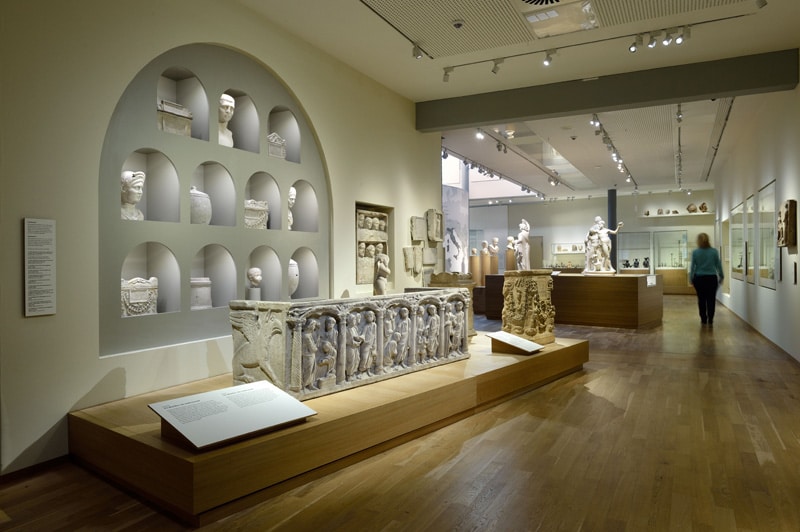The Rijksmuseum van Oudheden (RMO) in Leiden reopens on Tuesday 15 December after a major renovation and asbestos remediation. The museum immediately unpacks with a completely revamped Classics department: Greeks, Romans and Etruscans. There will also be three small temporary exhibitions.
Wie de hal van het museum betreedt, merkt niet meteen verschil: de Egyptische Taffehtempel staat gelukkig nog gewoon op zijn plaats, maar dat geldt ook voor kassa, café, winkel en garderobe. Toch is er veel gebeurd sinds 10 mei, toen het museum sloot. Meer dan 500 m3 asbest is verwijderd, onder andere van achter de natuurstenen wanden van de Taffeh-hal. Maar ook klimaatbeheersing, brandveiligheid en logistieke zaken zijn verbeterd.
Wisseltruc
Voor de (vaste) bezoeker is de belangrijkste verandering een grote wisseltruc. In de twee boven elkaar gelegen zalen waar voorheen de tijdelijke tentoonstellingen waren, zit nu de vaste collectie Klassieke Wereld. De tentoonstellingsruimte is verhuisd naar de omgang op de 1e verdieping boven de grote hal. Deze ruimte gaat pas in april 2016 open. Tot die tijd heeft het museum drie kleine exposities, waarover later meer.
Het RMO kiest voor gefaseerde vernieuwing. Al eerder kregen het Nabije Oosten en de archeologie van Nederland nieuwe presentaties. In oktober 2016 volgt Egypte, een afdeling die tot dan gesloten blijft, en in 2017 Romeins Nederland.
Klassieke Wereld: less is more
In de opstelling Klassieke Wereld streefde conservator Ruurd Halbertsma naar wat Aristoteles rhythmos noemde, een innerlijke beweging die geen rationele bewondering afdwingt maar het gevoel raakt. In de inderdaad prachtig ingerichte zalen valt het een en ander op.
- Er is minder ruimte, dus er is gekozen voor een less is more-concept van louter topstukken.
- De kwaliteit van die topstukken komt extra goed tot zijn recht door de uitgebreide restauraties aan vooral de Griekse vazen en door de uitstekende belichting. Het is een winstpunt van het led-tijdperk dat veel museale objecten meer licht mogen hebben dan voorheen, omdat ledverlichting minder warmte afgeeft.
- Voor wat betreft de restauraties: bij het corrigeren van foutieve restauraties uit de 19e eeuw ontstond volgens restaurator Renske Dooijes soms een dilemma: is die oude restauratie immers inmiddels ook niet historisch erfgoed geworden? Een videopresentatie op zaal vertelt hier meer over, maar er is ook een interessant blog op de website te vinden.

Links de oude 19-de eeuwse restauratie. De krans om het hoofd heeft de verkeerde vorm en lijkt zo meer op een kroon. Rechts de nieuwe, nog niet geretoucheerde aanvulling (foto (C) RMO) - De getoonde stukken vertegenwoordigen niet langer geïsoleerde culturen (‘de Grieken, bakermat van onze beschaving’) maar laten context en interactie met andere volkeren zien. Een eigentijdse benadering, maar een rake.Op de tweede etage zien we hoe de Grieken invloeden absorbeerden van bijvoorbeeld Egyptenaren (beeldhouwkunst) en Perzen. Op de eerste etage zijn het de Grieken die juist anderen inspireren: Romeinen natuurlijk, maar ook Etrusken en diezelfde Egyptenaren: de laatste Egyptische dynastie, de Ptolemaeën, stamde uit een Griekse familie. Projecties op de vloer tonen de indrukwekkend complexe betrekkingen. Verderop op de eerste verdieping zijn de collecties Etrusken en Romeinen te zien. Sluitstuk vormen een aantal Romeinse urnen en grafmonumenten in een columbarium, een Latijns woord dat niets anders blijkt te betekenen dan duiventil. Romeinse grafhumor.

Toegankelijker
Of minder stukken mooier tonen uiteindelijk de juiste keuze is, blijft een vraag. Veruit de meeste bezoekers zullen door de betere en toegankelijkere opstelling meer te zien krijgen dan voor de verbouwing, maar wie uit wetenschappelijke interesse de diepte in wil, wordt nu mogelijk beperkt door de kleinere hoeveelheid getoond materiaal.
Het museum biedt ook een nieuwe audiotour. Deze is niet meer alleen voor kinderen. Er zijn nu versies voor kinderen én volwassenen. Beide tours kun je met hetzelfde apparaat beluisteren. Scan het doelgroepicoontje bij een voorwerp en je hoort de gewenste versie.
Kindertour
De kindertour is ingesproken door Nienke de la Rive Box van Het Klokhuis. Vooral haar praktische aanwijzingen werken goed. Om inzichtelijk te maken dat vroege Griekse kouros– en korèbeelden nog veel op Egyptische beelden leken, legt zij bijvoorbeeld uit hoe je zelf in zo’n houding kunt gaan staan. Minder toegankelijk zijn sommige formuleringen: een sfinx uitleggen als ‘mythisch’ wezen dat raadsels opgaf aan ‘passerende’ reizigers veronderstelt wel enige ontwikkeling bij de luisteraartjes.
Drie tijdelijke tentoonstellingen
Zolang de grote ruimte voor tijdelijke tentoonstellingen nog niet open is, presenteert het Rijksmuseum van Oudheden drie kleine exposities:
1. Maas en mens
Vondsten uit het Nederlandse stroomgebied van de Maas. Nu eens niet gerangschikt op tijdperk, maar op de plaats waar ze gevonden zijn. Al zit er hier en daar toch wat chronologische samenhang in. Zo passeren we onderweg van Maastricht naar Maasvlakte overwegend Romeinse vondsten in de streek rond Nijmegen. Onder Dordrecht vonden archeologen resten van het dorp Kruiskerke, verdronken in de Sint-Elizabethsvloed van 1421. Omdat de tentoonstelling een periode bestrijkt van de Neanderthalers tot nu verliest deze soms wat aan scherpte, maar er zijn wel leuke ontdekkingen te doen.
2. Pracht en precisie
Uit het wegbezuinigde geldmuseum in Utrecht erfde het RMO de collectie gesneden stenen (gemmen, cameeën en overige). Na uitvoerig onderzoek, het beschrijven van de items en het maken van 6500 foto’s toont het museum de bijzonderste exemplaren in een boekje en een kleine tentoonstelling. De vaak piepkleine stenen, soms in een ring of rolzegel gezet, zijn niet altijd even makkelijk te zien, maar de prachtige foto’s vullen het beeld aan. Een kleine selectie is gefotografeerd door de Amerikaanse kunstenaar Stephen Sacks, die de ziel ervan heeft gepoogd bloot te leggen met speciale fotoprocedés.
3. Euro meltdown
Deze zelfde Sacks fotografeerde ook moderne euromunten, die per ongeluk ten prooi zijn gevallen aan de vuilverbranding. De gedachte is, dat het eigentijdse archeologische vondsten zijn met hun verweerde kleuren en gehavende vorm. Dat ziet er bij de ene foto overtuigender uit dan bij de andere. Erg geestig is het Atheense uiltje op een Griekse euro – een afbeelding ontleend aan antieke Atheense munten. Hier wordt de foto echt dubbellaags archeologie.

